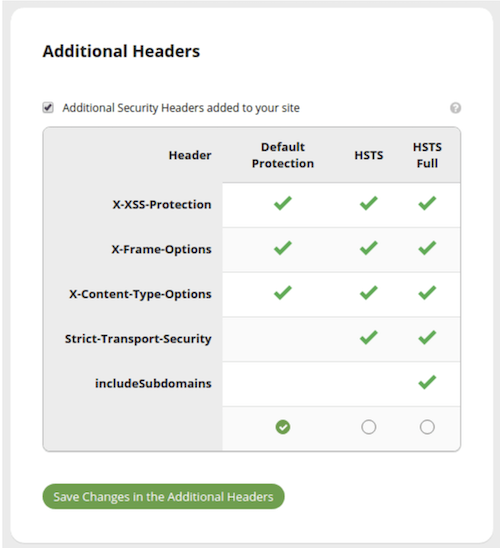Turn on Advanced Security Options for my Web Application Firewall (WAF)
Seguridad del sitio web proporciona una serie de opciones diferentes para ayudar a adaptar la seguridad del firewall a su sitio web.
- Ve a tu GoDaddy página del producto .
- En Seguridad del sitio web y copias de seguridad , al lado de la cuenta de Seguridad del sitio web que deseas administrar, selecciona Administrar .
- En Firewall/CDN , selecciona
 Estado verde ,
Estado verde , Estado amarillo , o
Estado amarillo , o Estado rojo .
Estado rojo .
- Selecciona Configuración.
- Selecciona Seguridad .
- En la página Seguridad , verás Opciones de seguridad avanzadas . A continuación se muestra una lista de las opciones de seguridad que puedes activar para ajustar tu firewall.
Opciones de seguridad avanzadas Panel de administración restringido solo a direcciones IP permitidas Most popular content management systems have an administrative panel (for example: /wp-admin on WordPress or /administrator on Joomla). If you set it to On, only Allowed IP addresses will be able to access those directories. Warning: If you have a membership site and you allow anyone to create an account and login there, do not enable this option.XMLRPC, comentarios y trackbacks bloqueados If your site does not allow comments (or trackbacks/pingbacks), or if you use an external commenting system (like Disqus or Facebook comments), you can block any comment attempt, since it's likely to be spam. Evita que se envíe HTML sin filtrar a tu sitio This option prevents users from inserting or sending unfiltered HTML content to your site. It will block things like iframes and script calls from being used. If you have a forum or membership site and you allow your users to send messages and post open content, do not enable this option. Allowed IP addresses are not affected by this setting. Detener la carga de PHP o contenido ejecutable Esta opción evitará que alguien cargue contenido PHP, Perl o ejecutable a tu sitio. Recomendamos habilitar esta opción a menos que permita a los usuarios hacer cargas. Ten en cuenta que las direcciones IP permitidas aún pueden realizar cargas. Habilitar la protección DDOS de emergencia La protección contra inundaciones HTTP evitará que cualquiera que use un navegador sin JavaScript habilitado pueda visitar el sitio (excepto los principales motores de búsqueda). Esto es muy útil cuando el sitio está bajo DDOS. Puedes desactivar esta opción una vez que todo se normalice. Nota: Esta opción puede evitar que visitantes legítimos accedan a tu sitio web y solo debe aplicarse cuando tu sitio web no esté disponible debido a ataques de denegación de servicio distribuido (DDoS).
Bloquear proxies anónimos y los tres principales países de ataque Enabling this option will prevent anyone with an IP address from China, Russia or Turkey from interacting with your site. They are still able to view all content but cannot register an account, submit comments or attempt to login. The same restriction applies to users using anonymous proxy services to hide their IP addresses. Filtro de bot agresivo Esta configuración bloquea los agentes de usuario no válidos que no coinciden con los navegadores reales, como los agentes de usuario vacíos, los agentes de usuario que comienzan con PHP/ y los agentes de usuario incorrectos de los navegadores comunes. Forzar el paso del nombre de host a través de TLS/SSL Esta opción forzará el paso del nombre de host durante el protocolo de enlace SSL/TLS. Note: Enabling this may break your site. Do not enable this unless your site is already broken.
Detección de evasión avanzada This option will enable our advanced evasion detection signatures. We recommend keeping it on, but if your site supports URL’s with non-ascii characters (like Japanese, Hindi, Russian, etc.) you may need to disable it. - Selecciona Guardar opciones de seguridad avanzadas .
Additional headers
HTTP security headers tell your browser how to behave when handling your site’s content. This provides another layer of security by helping to mitigate attacks such as Cross-Site Scripting (XSS) and Clickjacking.
Note: If you allow other sites to ‘iframe’ your content, do not enable this option.
- Default protection: This option will add the following headers to your site: X-XSS-Protection, X-Frame-Options, X-Content-Type-Options.
- HSTS: This option will add the following headers to your site: X-XSS-Protection, X-Frame-Options, X-Content-Type-Options and Strict-Transtport-Security.
- HSTS Full: This option will add the following headers to your site including subdomains: X-XSS-Protection, X-Frame-Options, X-Content-Type-Options and Strict-Transport-Security.

Más información
- Si agregas o eliminas opciones de seguridad en algún momento, asegúrate de borrar el caché en tu firewall .